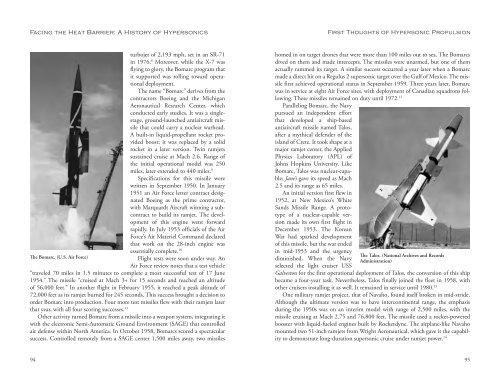Facing the Heat Barrier - NASA's History Office
Facing the Heat Barrier - NASA's History Office
Facing the Heat Barrier - NASA's History Office
Create successful ePaper yourself
Turn your PDF publications into a flip-book with our unique Google optimized e-Paper software.
<strong>Facing</strong> <strong>the</strong> <strong>Heat</strong> <strong>Barrier</strong>: A <strong>History</strong> of Hypersonics<br />
turbojet of 2,193 mph, set in an SR-71<br />
in 1976. 8 Moreover, while <strong>the</strong> X-7 was<br />
flying to glory, <strong>the</strong> Bomarc program that<br />
it supported was rolling toward operational<br />
deployment.<br />
The name “Bomarc” derives from <strong>the</strong><br />
contractors Boeing and <strong>the</strong> Michigan<br />
Aeronautical Research Center, which<br />
conducted early studies. It was a singlestage,<br />
ground-launched antiaircraft missile<br />
that could carry a nuclear warhead.<br />
A built-in liquid-propellant rocket provided<br />
boost; it was replaced by a solid<br />
rocket in a later version. Twin ramjets<br />
sustained cruise at Mach 2.6. Range of<br />
<strong>the</strong> initial operational model was 250<br />
miles, later extended to 440 miles. 9<br />
Specifications for this missile were<br />
written in September 1950. In January<br />
1951 an Air Force letter contract designated<br />
Boeing as <strong>the</strong> prime contractor,<br />
with Marquardt Aircraft winning a subcontract<br />
to build its ramjet. The development<br />
of this engine went forward<br />
rapidly. In July 1953 officials of <strong>the</strong> Air<br />
Force’s Air Materiel Command declared<br />
that work on <strong>the</strong> 28-inch engine was<br />
essentially complete. 10<br />
Flight tests were soon under way. An<br />
Air Force review notes that a test vehicle<br />
“traveled 70 miles in 1.5 minutes to complete a most successful test of 17 June<br />
1954.” The missile “cruised at Mach 3+ for 15 seconds and reached an altitude<br />
of 56,000 feet.” In ano<strong>the</strong>r flight in February 1955, it reached a peak altitude of<br />
72,000 feet as its ramjet burned for 245 seconds. This success brought a decision to<br />
order Bomarc into production. Four more test missiles flew with <strong>the</strong>ir ramjets later<br />
that year, with all four scoring successes. 11<br />
The Bomarc. (U.S. Air Force)<br />
O<strong>the</strong>r activity turned Bomarc from a missile into a weapon system, integrating it<br />
with <strong>the</strong> electronic Semi-Automatic Ground Environment (SAGE) that controlled<br />
air defense within North America. In October 1958, Bomarcs scored a spectacular<br />
success. Controlled remotely from a SAGE center 1,500 miles away, two missiles<br />
94<br />
First Thoughts of Hypersonic Propulsion<br />
homed in on target drones that were more than 100 miles out to sea. The Bomarcs<br />
dived on <strong>the</strong>m and made intercepts. The missiles were unarmed, but one of <strong>the</strong>m<br />
actually rammed its target. A similar success occurred a year later when a Bomarc<br />
made a direct hit on a Regulus 2 supersonic target over <strong>the</strong> Gulf of Mexico. The missile<br />
first achieved operational status in September 1959. Three years later, Bomarc<br />
was in service at eight Air Force sites, with deployment of Canadian squadrons following.<br />
These missiles remained on duty until 1972. 12<br />
Paralleling Bomarc, <strong>the</strong> Navy<br />
pursued an independent effort<br />
that developed a ship-based<br />
antiaircraft missile named Talos,<br />
after a mythical defender of <strong>the</strong><br />
island of Crete. It took shape at a<br />
major ramjet center, <strong>the</strong> Applied<br />
Physics Laboratory (APL) of<br />
Johns Hopkins University. Like<br />
Bomarc, Talos was nuclear-capable;<br />
Jane’s gave its speed as Mach<br />
2.5 and its range as 65 miles.<br />
An initial version first flew in<br />
1952, at New Mexico’s White<br />
Sands Missile Range. A prototype<br />
of a nuclear-capable version<br />
made its own first flight in<br />
December 1953. The Korean<br />
War had sparked development<br />
of this missile, but <strong>the</strong> war ended<br />
in mid-1953 and <strong>the</strong> urgency<br />
diminished. When <strong>the</strong> Navy<br />
selected <strong>the</strong> light cruiser USS<br />
The Talos. (National Archives and Records<br />
Administration)<br />
Galveston for <strong>the</strong> first operational deployment of Talos, <strong>the</strong> conversion of this ship<br />
became a four-year task. Never<strong>the</strong>less, Talos finally joined <strong>the</strong> fleet in 1958, with<br />
o<strong>the</strong>r cruisers installing it as well. It remained in service until 1980. 13<br />
One military ramjet project, that of Navaho, found itself broken in mid-stride.<br />
Although <strong>the</strong> ultimate version was to have intercontinental range, <strong>the</strong> emphasis<br />
during <strong>the</strong> 1950s was on an interim model with range of 2,500 miles, with <strong>the</strong><br />
missile cruising at Mach 2.75 and 76,800 feet. The missile used a rocket-powered<br />
booster with liquid-fueled engines built by Rocketdyne. The airplane-like Navaho<br />
mounted two 51-inch ramjets from Wright Aeronautical, which gave it <strong>the</strong> capability<br />
to demonstrate long-duration supersonic cruise under ramjet power. 14<br />
95
















